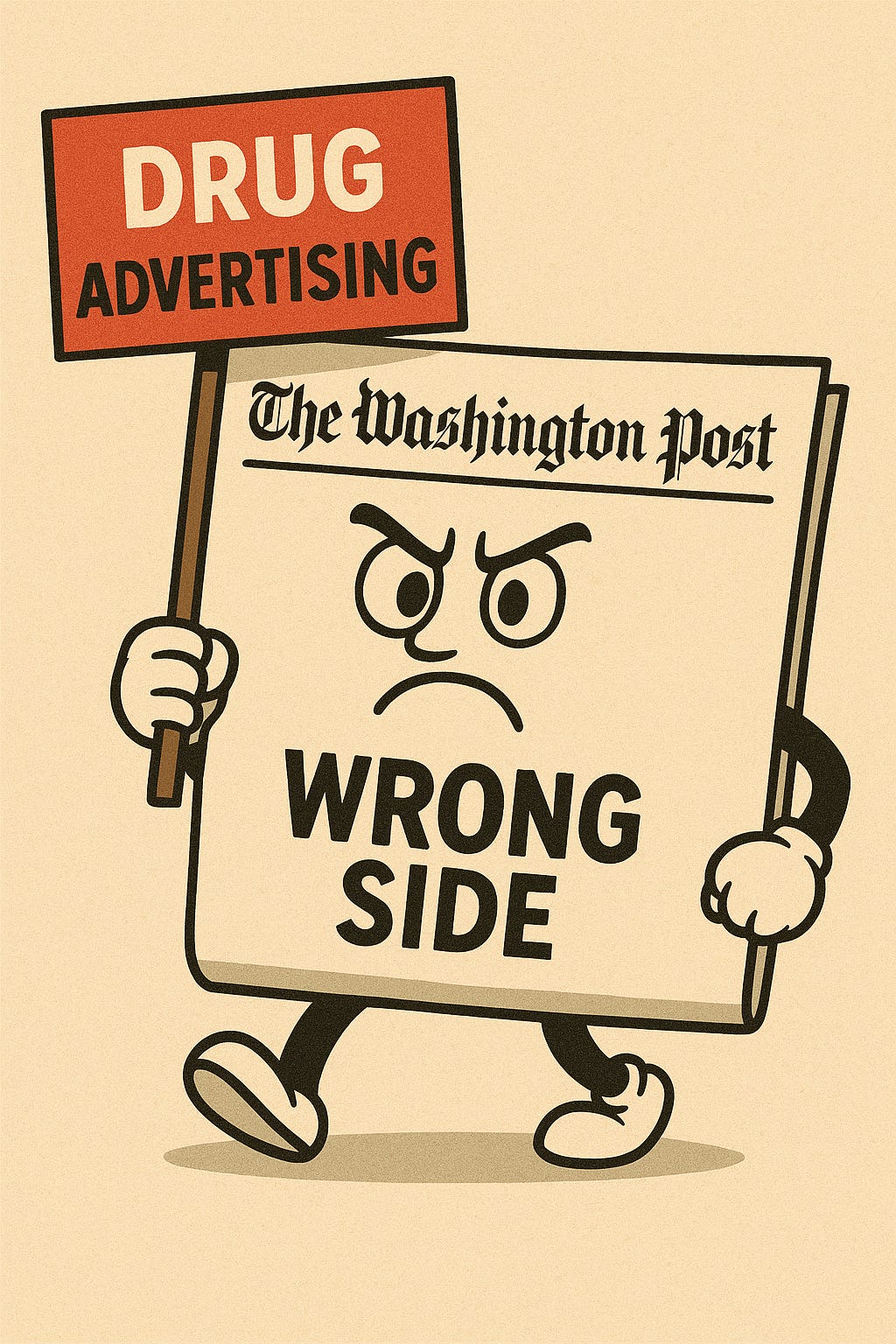America is Unhealthy, and the Washington Post Thinks That’s Just Fine
On July 28, 2025, The Washington Post published an editorial defending direct-to-consumer (DTC) pharmaceutical advertising. The piece argued that while drug commercials may be annoying, they ultimately help make Americans healthier by encouraging people to get diagnosed and treated. The editorial pointed to a recent economic study that found a ten percent increase in ad viewership resulted in a 5.4 percent rise in prescriptions, including for generic drugs, and mostly among people seeking treatment for the first time.
Um….this is not a public health victory. It’s a pharmaceutical marketing success story, one that says more about the power of the drug companies and corporate advertising than the health of the American people.
We are the only two countries in the world, alongside New Zealand, that allow prescription drug companies to advertise directly to consumers.
That fact alone should give us pause.
Most developed nations prohibit this practice because it leads to overprescribing, over-treatment, inflated costs, and the medicalization of normal human experiences. But in the United States, we treat pharmaceutical advertising as just another slice of capitalism, one where the stakes happen to be human life, chronic illness, and quality of care.
The Washington Post would have you believe that more prescriptions mean better health. But let’s take a truthful look at the state of American health in 2025.
We are among the sickest high-income populations on Earth. More than 40 percent of adults are obese, and rates of severe obesity have doubled in the past two decades. Chronic illnesses like diabetes, hypertension, and autoimmune conditions have reached epidemic levels. More than one in ten Americans has diabetes, and nearly 90 million more are pre-diabetic. Life expectancy in the United States has declined in recent years, a rare and damning trend in the developed world. And despite spending nearly 4.5 trillion dollars annually on healthcare, nearly 18 percent of our gross domestic product, we rank dead last among wealthy nations in health outcomes, access, and efficiency.
And perhaps most staggering, over 90 percent of American adults are metabolically unhealthy. That means they have at least one of the following: high blood sugar, elevated blood pressure, high triglycerides, low HDL (the “good” cholesterol), or an unhealthy waist circumference. These are the five markers used to measure metabolic health, and failing even one of them is enough to increase risk for heart disease, stroke, cancer, and premature death. Only about one in 14 American adults meets the criteria for optimal metabolic function, a devastating reflection of how deeply lifestyle-related disease has taken root.
We have a system that promotes sedentary living, ultra-processed food, chronic stress, and environmental toxins at every turn.
Drug ads are not solving this. They are part of the problem.
When someone sees a commercial for a new diabetes drug during an NFL game, they are not learning how to eat better, sleep deeper, move more, or reduce chronic stress. They are learning that if they feel a certain way—tired, bloated, depressed—there’s a pill to fix it. And if that pill causes weight gain, impotence, or liver failure, don’t worry, there’s another commercial coming right after with a fix for that too.

The Post’s editorial board’s claim that drug ads increase initiation of treatment may be technically accurate, but it is intellectually dishonest to frame that as inherently good.
What kind of treatment? For whom? And why? Are we encouraging evidence-based, root-cause interventions that reduce disease burden long-term? Or are we pushing expensive medications with marginal benefit, designed to manage symptoms rather than heal bodies?
To suggest that drug advertising “helps make us healthier” is to ignore a mountain of evidence to the contrary. The American Medical Association, public health researchers, and policy experts have long warned that DTC drug ads mislead patients, strain the doctor-patient relationship, and inflate demand for brand-name drugs over generics. In response, bipartisan legislation has recently been introduced in Congress to ban DTC drug ads entirely, a rare moment of agreement in a fractured political landscape.
But instead of championing that shift, The Washington Post chooses to normalize the status quo. And that status quo is failing.
If we truly cared about making Americans healthier, we would stop flooding our airwaves with fast food and pharma ads and start investing in what works: nutrition education, mental health support, access to whole foods, safer built environments, toxin reduction, and truly preventative care. Instead of reacting to disease, we would focus on creating conditions for health.
But that does not sell.
So long as media outlets rely on pharmaceutical companies for advertising revenue, we can expect more editorials like this, disguised as public service but functioning as corporate apologia. And as long as we keep mistaking drug sales for health progress, we will continue down the path we are on: sicker, more medicated, and increasingly disempowered.
We do not need more or better pharmaceutical ads. We need better health.
